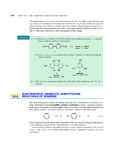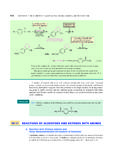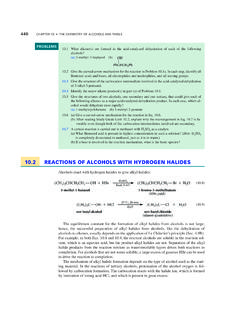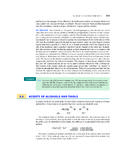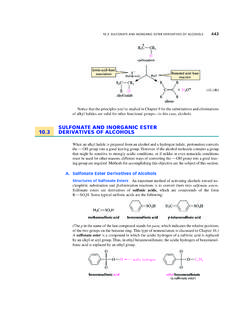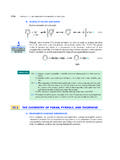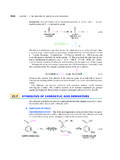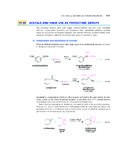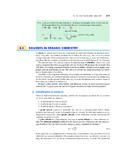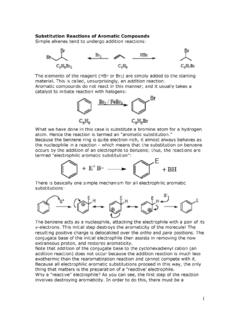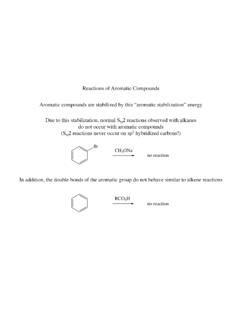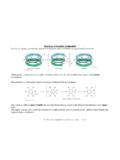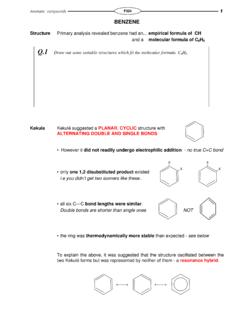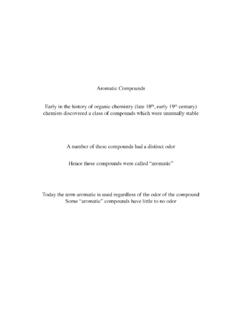Transcription of NUCLEOPHILIC AROMATIC SUBSTITUTION …
1 828 CHAPTER 18 THE CHEMISTRY OF ARYL HALIDES, VINYLIC HALIDES, AND PHENOLS. TRANSITION-METAL CATALYSISB ecause an aryl cation is forced to assume a nonoptimal geometry and hybridization, it has avery high energy. The electron-withdrawing polar effect of the ring double bonds also desta-bilizes an aryl cation, just as a double bond destabilizes a vinylic cation. Thus, SN1 reactionsof aryl halides do not occur because they would require the formation of carbocation interme-diates aryl cations with very high that an aryl cation is quite different from the cation formed in electrophilic AROMATIC substitu-tion (Eq.)
2 , p. 753), in which the carbocation intermediate is stabilized by resonance. In an arylcation, the empty orbital is not part of the ring p-electron system but is orthogonal (at right angles)to it. Hence, this carbocation is notresonance-stabilized. The first direct observation of an aryl cation (the phenyl cation, Eq. ) was reported in 2000by chemists at the Ruhr-Universit t in Bochum, Germany, who trapped the cation at 4 K and ob-served it spectroscopically. Thus, aryl cations are known species. However, they are fartoo unstableto form from aryl halides under typical SN1 Within each series, arrange the compounds according to increasing rates of their reactions bythe SN1 E1 mechanism.
3 Explain your reasoning.(a)(b) AROMATIC SUBSTITUTION reactions OF ARYL HALIDESA lthough aryl halides do not undergo NUCLEOPHILIC SUBSTITUTION reactions by SN1 and SN2mechanisms, aryl halides that have one or more nitro groups ortho or para to the halogen un-dergo NUCLEOPHILIC SUBSTITUTION reactions under relatively mild conditions.( )ClHClvLL32)++NO2NH3O2 NvLL)NO2NH2O2N170 C, 6 h(pressure)1-chloro-2,4-dinitrobenzene2, 4-dinitroaniline(70% yield)( )LvLO2 NCH3O_K|F+LvLO2NF_K|OCH3+p-fluoronitrobe nzenep-nitroanisole(93% yield)67 C, 10 minCH3 OHkLCH3 ClClCH"LkLBrBAC0 LCH3 BrCH"LcLACH2 BrC"ABLcLCH3 BrCH" 11/26/08 9:09 AM Page NUCLEOPHILIC AROMATIC SUBSTITUTION reactions OF ARYL HALIDES829 These reactions are examples of NUCLEOPHILIC AROMATIC SUBSTITUTION : SUBSTITUTION that occursat a carbon of an AROMATIC ring by a NUCLEOPHILIC s examine some of the characteristics of this mechanism.
4 Like SN2 reactions , nucle-ophilic AROMATIC SUBSTITUTION reactions involve nucleophiles and leaving groups, and they alsoobey second-order rate k[aryl halide][nucleophile]( )However, NUCLEOPHILIC AROMATIC SUBSTITUTION reactions do not involve a concerted backsidesubstitution for the reasons given in Sec. Two clues about the reaction mechanism comefrom the reactivities of different aryl halides. First, the reaction is faster when there are morenitro groups ortho and para to the halogen leaving group:Second, the effect of the halogen on the rate of this type of reaction is quite different from thatin the SN1 or SN2 reaction of alkyl halides.
5 In NUCLEOPHILIC AROMATIC SUBSTITUTION reactions , arylfluorides are most of aryl halides:ArLF>>ArLCl 'ArLBr 'ArLI( )In SN2 and SN1 reactions of alkylhalides, the reactivity order is exactly the reverse: alkyl flu-orides are the least reactive alkyl halides (Secs. and ).These data are consistent with a reaction mechanism in which the nucleophile reacts at thehalide-bearing carbon below (or above) the plane of the AROMATIC ring to yield a resonance-stabilized anion called a Meisenheimer complex. In this anion, the negative charge is delocal-ized throughout the p-electron system of the ring.
6 Formation of this anion is the rate-limitingstep in many NUCLEOPHILIC AROMATIC SUBSTITUTION reactions .( )FvLLO2 Nlrate-limiting!!F/LO2N__OCH312 OCH3122LO2N_33LO2N_na Meisenheimer complex%"FOCH312%"FOCH3112%"( )ClvL+_OCH3 0no reaction( )Cl_+ClvLL+_OCH3O2 NvLLO2 NOCH31( )ClCl_vLL)++NO2_OCH3 OCH3O2 NvLL)NO2O2 Nrelativerate105 11/26/08 9:09 AM Page 829830 CHAPTER 18 THE CHEMISTRY OF ARYL HALIDES, VINYLIC HALIDES, AND PHENOLS. TRANSITION-METAL CATALYSISThe negative charge in this complex is also delocalized into the nitro Meisenheimer complex breaks down to products by loss of the halide s see how this mechanism fits the experimental facts.
7 Ortho and para nitro groupsaccelerate the reaction because the rate-limiting transition state resembles the Meisenheimercomplex, and ortho and para nitro groups (but not meta nitro groups) stabilize this complex byresonance. Fluorine also stabilizes the negative charge by its electron-withdrawingpolar ef-fect,which is greater than the polar effect of the other halogens. Because theloss of halide isnot rate-limiting,the basicity of the halide, or equivalently, the strength of the carbon halogenbond, is not important in determining the reaction we have used aryl halides substituted with ortho- and para-nitro groups toillustrate NUCLEOPHILIC AROMATIC SUBSTITUTION , it stands to reason that other substituents that canprovide resonance stabilization to the Meisenheimer complex can also activate nucleophilicaromatic SUBSTITUTION .
8 (See, for example, Problem )Notice how the NUCLEOPHILIC AROMATIC SUBSTITUTION reaction differs from the SN2reactionofalkyl halides. First, there is an actual intermediate in the NUCLEOPHILIC AROMATIC SUBSTITUTION re-action the Meisenheimer complex. (In some cases, this is sufficiently stable that it can be di-rectly observed.) There is no evidence for an intermediate in any ,thenu-cleophilic AROMATIC SUBSTITUTION reaction is a frontside SUBSTITUTION ; it requires no inversion ofconfiguration. The SN2reactionofanalkylhalide,incontrast,is abacksidesubstitutionwithinversion of configuration.
9 Finally, the effect of the halogen on the reaction rate (Eq. ) isdifferent in the two reactions . Aryl fluorides react most rapidly in NUCLEOPHILIC AROMATIC sub-stitution, whereas alkyl fluorides react most slowly in SN2 Complete the following reactions . (No reactionmay be the correct response.)(a)(b) (c)LcLCH3 OHFCH3O_123CH3O+25 CLNO2$cCH3 OHFCH3(CH2)3S_123+LLNO2O2N$cheatClC2H5NH 22+( )vLLO2N/LO2N__OCH34F123F1233+OCH3%"( )2lLN_|3O13O13#MMM22lN___|O13O13A!!FOCH3 %"FOCH3%"STUDY GUIDE LINK of AromaticSubstitution 11/26/08 9:09 AM Page INTRODUCTION TO TRANSITION-METAL CATALYZED Which of the two compounds in each of the following sets should react more rapidly in a nu-cleophilic AROMATIC SUBSTITUTION reaction with CH3O_in CH3OH?
10 Explain your answers.(a)(b) TO TRANSITION-METAL CATALYZED REACTIONSWe ve just learned that SN1 and SN2 reactions cannot be carried out on either aryl or vinylichalides. However, reactions that lookvery much like NUCLEOPHILIC substitutions canbe carriedout using certain transition-metal catalysts. Here are some reaction, called the Heck reaction,has become very important in organic synthesis. We llrevisit this reaction in Sec. Notice the formation of the carbon carbon bond and the re-lease of bromide as HBr. Superficially, it looks as if the conjugate-base anion of ethylene dis-places bromide ion from the AROMATIC ring.
